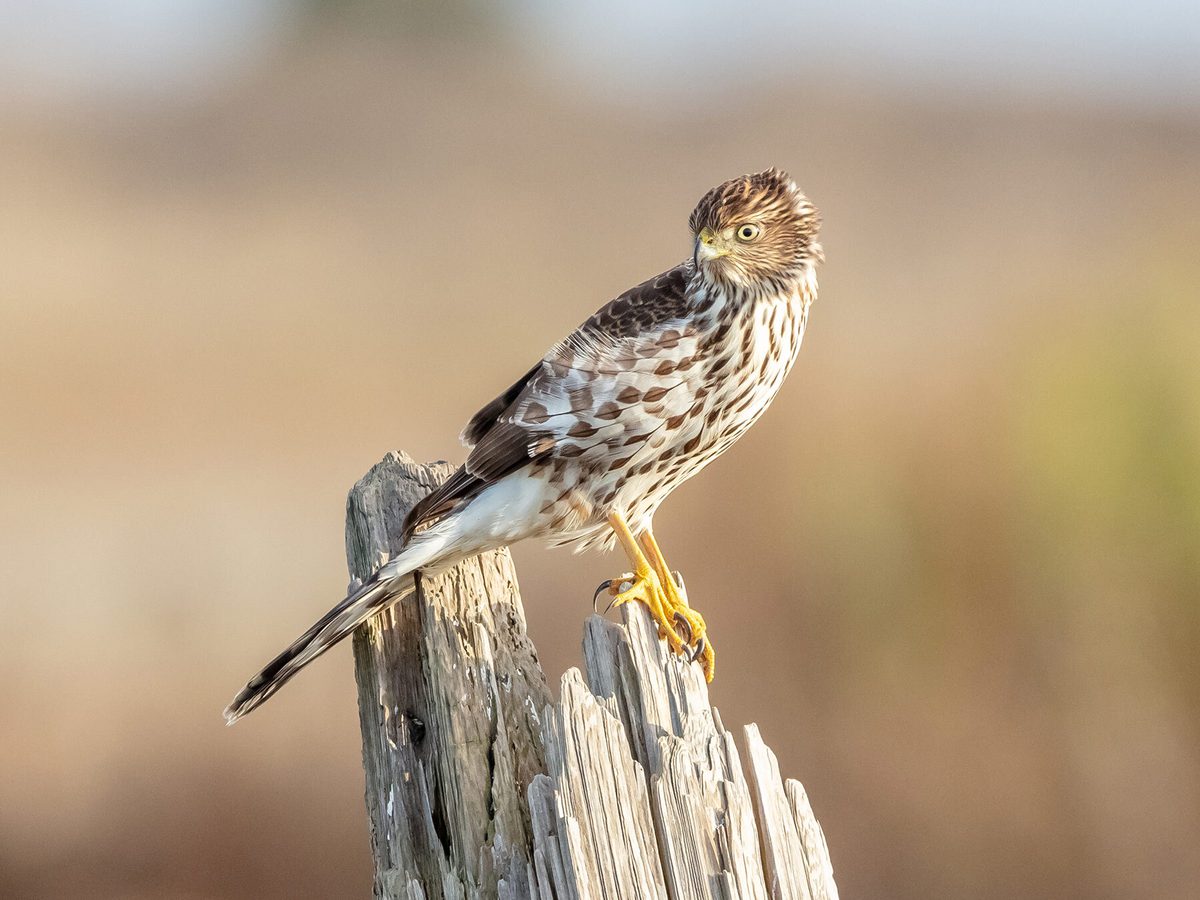Hawks eat primarily small mammals like mice, voles, rabbits, and squirrels, but their diet also includes birds, reptiles, amphibians, and even insects, depending on the species and season.
Their remarkable hunting abilities, including vision that can spot prey from hundreds of feet in the air, allow them to be opportunistic predators across diverse habitats throughout the United States.

A Sharp-shinned Hawk perched on a tree stump, looking for food
Masters of the Hunt
These raptors primarily hunt small mammals - mice, voles, rabbits, and squirrels make up the bulk of their diet across most species.
Watch a Red-tailed Hawk hunting, and you'll notice a distinct pattern: they soar in wide circles, then suddenly hover, focusing intensely on something below before tucking their wings and diving at speeds reaching 120 mph.
That distinctive screech you hear in movies? That's actually a Red-tailed Hawk's hunting call.
Different hawk species have evolved specialized hunting techniques:
- Aerial Pursuit - Fast-paced hunting in forests where acrobatics, surprise, and speed are crucial for catching birds
- Co-operative Hunting - Multiple hawks working together to catch larger prey, with some flushing out animals while others wait to ambush
- High Soaring - Large-winged hawks circling at high altitudes, stressing prey before swooping down for the kill
- Low Soaring - Flying close to the ground in open areas, spooking prey into running and exposing themselves
- Hover and Pounce - Flying low until spotting prey, then hovering directly above before diving down
- Perch and Swoop - Sitting on prominent branches overlooking hunting grounds, then swooping down when prey appears
Cooper's Hawks weave through dense forest canopies with astonishing agility to capture songbirds mid-flight. If you've noticed fewer birds at your backyard feeder, scan nearby trees - you might spot the slate-blue back of a Cooper's Hawk patiently waiting for its opportunity.
Sharp-shinned Hawks employ similar tactics but focus on smaller prey. They're especially common during migration seasons when they follow songbird flocks. Stand near a ridge line during fall migration, and you might witness these hawks darting through flocks of warblers, causing panicked scattering as they single out a target.

A Red-shouldered Hawk in a backyard
Beyond Mammals and Birds
Hawks aren't picky eaters by any means. Beyond mammals and birds, their menu includes:
- Reptiles like snakes and lizards (especially favored by Harris's Hawks in the Southwest)
- Amphibians around wetland areas
- Large insects, including grasshoppers, dragonflies, and crickets
- Aquatic prey such as crayfish, prawns, and even crabs in coastal areas
- Even fish, particularly for species like Ospreys (sometimes classified with hawks)
As strict carnivores, hawks never eat plant material - no fruits, seeds, or vegetation ever appear in their diet.
What Baby Hawks Eat
Nestling hawks depend entirely on their parents for food. The adults typically hunt smaller prey items that are easier to tear into manageable pieces - things like small rodents, lizards, and insects.
Parents often regurgitate partially digested food for very young nestlings. As the chicks grow, parents bring whole prey items to the nest, eventually teaching the fledglings to hunt for themselves before they become independent.
Seasonal Dining Habits
Seasonal shifts dramatically affect hawk diets. During spring and summer, nestlings require protein-rich food, so parent hawks increase their hunting intensity, sometimes making 15-20 kills daily to feed hungry chicks.
Watch open fields after hay cutting in summer - hawks will patrol recently cut areas where rodents suddenly lose their cover.
Winter brings different challenges. Northern species, like Rough-legged Hawks, migrate south and adapt to unfamiliar prey. Heavy snow cover forces them to conserve energy, sometimes leading to opportunistic feeding on carrion - something rarely observed during warmer months.
Winter diet often narrows to focus primarily on voles and other rodents that remain active beneath the snow.

A Black Kite in the city
Urban Adaptations
Urban hawks have adapted surprisingly well to city life. Red-shouldered Hawks in suburban areas now regularly hunt not just natural prey but also raid backyard chicken coops and have been spotted snatching small pets. If you keep smaller pets, always scan the skies in hawk territory before letting them roam freely.
Suburban bird feeders have become hunting hotspots for Cooper's and Sharp-shinned Hawks, which specialize in catching other birds. This sometimes creates conflicts with backyard bird enthusiasts, but these hawks are simply following their natural hunting instincts.
Hawks in Your Backyard
Despite their occasionally fearsome reputation, hawks provide excellent natural pest control. They help keep rodent populations in check, which can protect gardens, reduce disease spread, and even protect koi ponds (hawks won't dive for fish, but they'll hunt the mammals that do).
To attract hawks to your property:
- Preserve tall trees with sturdy branches for perching and nesting
- Maintain some open areas where hawks can spot ground prey
- Consider leaving part of your yard naturalized to support the food chain
- Be patient - hawks are territorial and may take time to discover your yard
Hunting Success
The hunting success rate for most hawks hovers around 20% - meaning most attempts fail.
This explains their opportunistic nature and willingness to adapt their diet as needed throughout the year and across their range from Alaska to the southern borders of the United States.

Red-tailed Hawk in the winter
